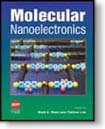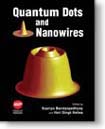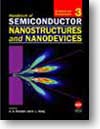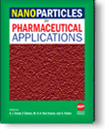纳米科技经典图书资料推荐介绍专栏
Handbook of Nanostructured Biomaterials
and Their Applications in Nanobiotechnology

2-Volume Set
Edited by
Hari Singh Nalwa
Editor-in-Chief,
Journal of Nanoscience and Nanotechnology
2005 ca. 1000 pages, Hardcover
ISBN: 1-58883-004-7
US$899.00

Handbook of Nanostructured Biomaterials and Their Applications in Nanobiotechnology brings together under a single cover all aspects of the nanostructured biomaterials including all types of nanoscale biomaterials, biocompatible surfaces, functional bioengineered materials, polypeptides, bioceramics, biopolymers, organic-inorganic hybrid biomaterials, nanocomposites, biological macromolecules such as proteins, peptides, nucleic acids, DNA-based self-assemblies, biomolecules, cells, and glycans, biochips, biocompatibility aspects of materials, interactions between biomaterials, cells, tissue and organs, cellular matrix interaction, drug delivery, biomaterials for orthopedic and cardiovascular applications, applications in drug and protein delivery, BioMEMS, dentistry, bone, bioanalysis, biosensors, biomedical implantation, biomechanics, bioinstrumentation, nanoscale physiology and pathology, nanoscale proteomics, instrumentation techniques for nanobioscience, nanoscale cellular and tissue engineering, etc. Broadly speaking, all important aspects dealing with the chemistry, physics, biology and engineering of nanostructured biomaterials and their applications in nanobiotechnology are covered. The two-volumes contain over 30 state-of-the-art review chapters written by over 70 internationally renowned experts from 10 countries. The handbook has been divided into two thematic volumes.
CONTENTS
Volume 1: Biomaterials
Optical Properties and Wettability of Nanostructured Biomaterials: Moth Eyes, Lotus Leaves,
and Insect Wings, G. Palasantzas, J. Th. M. De Hosson, K. F. L. Michielsen,
and D. G. Stavenga, The Netherlands
Glycolipid-Based Bionanomaterials, Dai Kitamoto, Kazunori Toma
and Masakatsu Hato, Japan
Biomineralized Inorganic Nanomaterials, Shu-Hong Yu, China
Biointerface, Bioconjugation, and Biomatrix Based on Bioinspired Phospholipid Polymers,
Kazuhiko Ishihara and Junji Watanabe, Japan
Functional Imaging of the Hierarchical Structure/Property Relationships in Bone, Dentin and the Dentin/Adhesive Interface, J. Lawrence Katz, Y. Wang, S. Bumrerraj, T. Nomura, A. Misra, Steven
J. Eppell, M. Tabib-Azar, and Paulette Spencer, USA
Nanostructure and Dynamics of Biocompatible Surfactant Monolayers and Bilayers,
H. E. Warriner, A. T. Ngo, J. A. Zasadzinski and Junqi Ding, USA
Interactions between Cells and Synthetic Nanofiber Extracellular Matrix, T. Yong, C. Xu
and S. Ramakrishna, Singapore
Interactions of Cells with Biomaterial Nanostructured Surfaces, Wei-Bor Tsai
and Chi-An Dai, Taiwan
Nanostructured Surface Roughness for the Control of Protein and Cell Functions,
Thomas J. Webster, USA
Imaging and Assembly of Nanoparticles in Biological Systems, Xiao-Hong Nancy Xu
and Rudrax N. Patel, USA
Nanostructure in Natural Bone and its Mimetic Fabrication, Fizhai Cui, Wei Zhang
and In-seop Lee, China/South Korea
Characterization of Physical Properties of Living Cells with Atomic Force Microscopy,
Adel Alhadlaq, Rupal Patel, Arnold I. Caplan, Donald P. Lennon, Naam T. Lewis
and Jeremy Mao, USA
Nanoscale Physico-Chemical Reactions at Bioceramics-Bone Tissues Interfaces,
E. Jallot, France
Resorbable Biomaterials, Yoshito Ikada, Japan
and much more …
Volume 2: Applications in Nanobiotechnology
Optical Nanocluster Chips and Arrays, Thomas G.M. Schalkhammer, The Netherlands
Functional Polymers for Bone Tissue Engineering Applications, Jie Song
and Carolyn R. Bertozzi, USA
Nanostructured Non-fouling Films for BioMEMS Applications, S. Sharma, K. C. Popat,
and Tejal A. Desai, USA
Inorganic/Polymer Nanocomposites for Dental Restorative and Bone Replacement Applications,
Qing Liu, USA
Self-assembling Nanostructured Injectable Polymeric Gels for Drug Delivery, M. Determan
and S. K. Mallapragada, USA
Engineering Surface-Erodible Polyanhydrides with Tailored Microstructure for Controlled Drug
and Protein Delivery, Amy S. Determan and Balaji Narasimhan, USA
Peptide Self-assembly and its Application in Drug Delivery, Pu Chen, Canada
Bioactive Nanomaterials in Bone Grafting and Tissue Engineering, R. Murugan
and S. Ramakrishna, Singapore
Nanostructured Scaffolds for Tissue Engineering and Regeneration, Victor J. Chen, Guobao Wei
and Peter X. Ma, USA
Polymer Nanofibers and Their Applications in Bioengineering, M. Kotaki, Z.-M. Huang,
S. Ramakrishna, Singapore
Nucleic Acid Engineered Nanomaterials and Nanodevices, Dan Luo and Yougen Li, USA
DNA-based Artificial Nanostructures: Fabrication, Properties, and Applications, Y. Sun
and Ching-Hwa Kiang, USA
Vesicles and Liposomes in Sensor Technology, Stavroula Sofou and James L. Thomas, USA
Protein Patterning for Applications in Biomaterials and Biodevices, K. G. Pruden and A. Panitch, USA
and much more …
KEY FEATURES
The first reference work ever published on nanostructured biomaterials and their applications.
A unique source of in-depth knowledge of recent advances in applications of nanostructured biomaterials.
Most up-to-date emerging aspects of nanobiomaterials and their applications in the field of nanotechnology.
Contains over 30 state-of-the-art chapters written by over 70 internationally renowned experts from 10 countries.
About 5,000 bibliographic citations and hundreds of illustrations, figures, tables, chemical structures and equations.
The handbook is intended for a wide audience including researchers, students, and professors working in the field of biomaterials, nanotechnology, materials science, polymer science and engineering, biomedical engineering, biophysics, biochemistry, etc.
[ Last edited by 604gq on 2007-4-29 at 14:07 ]![]() 返回小木虫查看更多
返回小木虫查看更多



 京公网安备 11010802022153号
京公网安备 11010802022153号
Handbook of Theoretical


and Computational Nanotechnology
10-Volume Set
Edited by
Michael Rieth and Wolfram Schommers Forschungszentrum Karlsruhe, Germany
Foreword by
Professor Pierre-Gilles de Gennes, Nobel Prize Laureate
2006 ca.8,000 pages, Hardcover
ISBN: 1-58883-042-X
US$5975.00
FROM THE FOREWORD
"Nanoscience is fashionable. All administrations in the Western world have stressed their interest in nano-objects and nanotechnologies. …The aim of the present handbook is to help us with the tools by suitable modelizations. It is written by leading experts, starting from general theoretical principles and progressing to detailed recipes. …Soon after the first wave, including this handbook, a certain form of nano-industry may be born."
Professor Pierre-Gilles de Gennes, Nobel Prize Laureate
ABOUT THIS HANDBOOK
The future applications of nanotechnology in high-tech industries require deep understanding of the theoretical and computational aspects of all kinds of materials and devices at a nanometer scale. Handbook of Theoretical and Computational Nanotechnology is the first single reference source ever published in field that offers such an unified approach covering all of the major topics dealing with theory, modeling, design and simulations of nanostructured materials and nanodevices, quantum computing, computational chemistry, physics and biology, nanomechanics, nanomachines, nanoelectronics, nanoprocesses, nanomagnetism, nano-optics, nanomedicines, nanobiotechnology, etc. This 10-volume (ca. 8,000 pages) handbook provides the first ideal introduction and an up-to-date survey of the fascinating new developments and interdisciplinary activities in the whole field presented by scientists working in different subject areas of science, engineering and medicine. This handbook is the most profound publication on this topic- the first treatment of the computational nanotechnology. This outstanding handbook presented by 265 world's leading scientists, is the most significant academic title ever published in this research field. This handbook has been divided into 10 thematic volumes by documenting computational treatment of nanomaterials and nanodevices.
CONTENTS (10-Volume Set, ca. 8,000 pages)
Atomic Design, Atomistic Modeling, Quantum Computers, ab Initio Methods, Atom Nano-optics, Computational Nanoelectronics, Computational Nanotechnology, Molecular Devices, Molecular Machines, Nanosurfaces, Bio-Molecular Motors, Molecular Motors, Molecular Dynamics, Meshfree Methods, Density Matrix Renormalization Method, Finite Element Method, Maxwell Solvers, Bionanotechnology, Embedded Atom Method, Tight-Binding Molecular Dynamics Method, Computational Modeling, Statistical Mechanical Modeling, Linear-Scaling Quantum Mechanical Methods, Equivalent-Continuum Modeling of Nanomaterials, Self-consistent P3M Simulation of Ion Channels, Multiscale Simulations of Nanomaterials and Nanodevices, Hierarchical Models of Nanomechanics and Micromechanics, Computational Nanomechanics of Materials, Nanotribology, Adhesion, Nanoindentation, Nanoscale Fracture Processes, Transport Phenomena, Proton and Electron Tranfer Processes, Flow Modeling in Fullerenes and Nanotubes, Atomistic Modeling of Nanoprous Materials, Nano-thermodyanamics, Quantum Chemistry, Computational Biology, Protein Folding, Computational Studies of DNA and RNA, Enzymes, Enzyme-Mimetics, Enzyme-Catalyzed Reactions, Nanomagnetics, Medical Nanorobotics, Biological Nanotubes, Design of proteins, Nanomedicines, Drug Design and Delivery, Ligand Docking, Computational Models for Genetics and Neurogenetics, Neuro-Genetic Information Processing, Nonlinear Optical Properties of Carbon Nanostructures, Optical Properties of Nanoclusters and Semiconductor Nanostructures, Modeling of Photonic Crystals and Nanostructures, Quantum Optics, Theoertical Physics, Computational Micromagnetics, Magnetic Nanomaterials and Nanodevices, Self-Assemblies, Modeling of Polymer Nanocomposites, Carbon Nanotube Composites, Diamonds, Fullerenes and Endofullerenes, Carbon Nanocones, Doped Nanomaterials, Superconducting Nanostructures, Embedded Quantum Dots and Nanowires, Molecular Wires, Nanocrystals, Computer Simulation of Surfaces, Conjugated Organic Polymers, Monte Carlo Simulations, Nano-thermodynamics of Surfaces, Mechanical Properties of Polymer-Carbon Nanotube Composites, Single and Multi-Wall Carbon Nanotubes, Ferroelectric Nanostructures, Silicon-Based Nanodevices, Single-Electron Devices and Nanocircuits, Single-Electron Transistors, Quantum Dot Lasers, Modeling of Nanodevices, Modeling of MEMS and NEMS, Biomechanism, Nanomedicines, Computational Chemistry, Quantum chemistry, Molecular Design, Nanomedicines and Nanodrugs design, Computational methods and Simulation Techniques from ab initio to Multiscale, Algorithms, Nanoscale Analysis of Defects, diffusion, Cascades, and Irradiation, Nanomembranes, Nanocatalysis, Nanometals, Polymer Nanostructures, Liquid Crystals, Nanocolloids, Monolayer and Multilayers, Tthin Films, Nanoengineering and Nanodesign Nano-CAD, Luminescence, Computational Methods for Simulating Quantum Computers, Wigner Function Based Device Modeling, etc.
10-VOLUME SET ( ca. 8,000 pages)
Volume 1: Basic Concepts, Nanomachines and Bionanodevices
Volume 2: Atomistic Simulations - Algorithms and Methods
Volume 3: Quantum and Molecular Computing, and Quantum Simulations
Volume 4: Nanomechanics and Multiscale Modeling
Volume 5: Transport Phenomena and Nanoscale Processes
Volume 6: Bioinformatics, Nanomedicine and Drug Delivery
Volume 7: Magnetic Nanostructures and Nano-optics
Volume 8: Functional Nanomaterials, Nanoparticles and Polymer Nanostructures
Volume 9: Nanocomposites, Nano-Assemblies, and Nanosurfaces
Volume 10: Nanodevice Modeling and Nanoelectronics
KEY FEATURES
The World's first handbook ever published in the field of theoretical and computational nanotechnology .
The first comprehensive reference dedicated to all disciplines of science, engineering. and medicine.
Most up-to-date reference source drawing on the past two decades of pioneering research.
About 140 Review chapters written by world leading scientists familiar with the current trends of nanotechnology.
8,000 pages written by 265 authors from 30 countries, truly international.
26,000 references, 4124 figures, 374 tables, and thousands of mathematical equations and formula.
Clearly written, self-contained, timely, authoritative, and most comprehensive contributions.
Extensive cross-refereeing in each chapter provides reader with a broader range of knowledge.
Multidisciplinary reference source for students, scientists, engineers, biologists, medical experts and related professionals.
READERSHIP
This handbook is an invaluable reference source for scientists, engineers and biologists working in the field of theoretical and computational nanotechnology and for individual research groups, libraries in the universities and industrial institutions, government, independent institutes, R&D and defense research laboratories. The handbook is intended for a broad audience working in the fields of quantum chemistry, physics, biology, materials science, medicine, electrical and electronics engineering, mechanical engineering, optical science, ceramic and chemical engineering, device engineering, aerospace engineering, computer science and technology, information technology, bioinformatics, biotechnology, medical sciences, surface science, polymer science and engineering.
ABOUT THE EDITORS
Dr. Michael Rieth is a Research Scientist at the Institute of Materials Research I(IMF-I) in the Forschungszentrum Karlsruhe, Germany since 2002. He is Head of the consulting company AIFT, Karlsruhe since 1987. He worked as a Researcher at the Institute of Materials Research II (IMF-II), Forschungszentrum Karlsruhe from 1995-99 and at the Engineering Science Department of University of Patras (Greece) from 1999-2000. He was Product Manager at AMA-Systems, Pforzheim, Germany from 2000-01. He received his M.Sc. (germ. Dipl. Ing.) degree in Electrical Engineering from the University of Karlsruhe in 1991 and his Ph.D. in Physics from the University of Patras (Greece) in 2001. Dr. Rieth published 23 research articles in refereed journals, two book chapters and four patents. He is the author of Nano-Engineering in Science and Technology (World Scientific, 2003), and was the Editor-in-Chief of the Journal of Computational and Theoretical Nanoscience (2004-2005). His main scientific interests are in atomistic modeling of metallic nanosystems and materials development for advanced fusion reactor applications.
Professor Dr. Wolfram Schommers is a Theoretical Physicist presently working at the Research Center of Karlruhe in Germany. He is also Professor of Theoretical Physics, Professor of Physics and Materials Sciences and Distinguished Professor in Europe, China and USA. He began his studies of Theoretical Physics at the Technical University of Munich, and continued his course-work at the University of Münster, receiving a Diploma in Physics. After a brief intermezzo in the industry, Prof. Schommers joined the Research Center of Karlsruhe. He received his Ph.D. (Dr. rer. nat.) in Theoretical Physics from the University of Karlsruhe. Prof. Schommers' scientific activities are concentrated on Computational and Theoretical Physics. His main fields of interest include Foundations of Physics, Liquids, Solids and Gases, Superionic Conductors, Surface Science, and Nanophysics as the basis for the investigation of properties nanometer-scale atomic devices, junctions, quantum dots and nanomachines. He has published the results of his research activities and thoughts in various scientific journals (214 articles and book chapters). In particular, Prof. Schommers is author and editor of the following books: Fundamentals of Nanometer Structuring; Structure and Dynamics of Surfaces I and II; Quantum Theory and Pictures of Reality; The Visible and the Invisible; Das Sichtbare und das Unsichtbare; Elemente des Lebens; What is Life?; Formen des Kosmos; Space and Time, Matter and Mind; Symbols, Pictures and Quantum Reality. Prof. Schommers is the Editor-in-Chief of the Journal of Computational and Theoretical Nanoscience (www.aspbs.com/ctn). He is also an editorial board member of various scientific journals, and he is the Principal Editor-in-Charge of the book series Foundations of Natural Science and Technology. He is an invited member of the Humboldt Academy, an invited member of the Academic Board of the Humboldt Society, and an invited member of the Advisory Board of Medical Ethics of the 21th Century,
Molecular Nanoelectronics


Edited by
Mark A. Reed and Takhee Lee
Department of Electrical Engineering, Yale University, USA
May 2003
411 pages, Hardcover
ISBN: 1-58883-006-3
US$395.00
Molecular Nanoelectronics is the first and sole reference source ever published to have overviews of nanoelectronics based on the nanometer scale building blocks such as organic molecules, nanoparticles, nanocrystals, nanotubes and nanowires. This book covers topics on transport theory through nanostructures, processing, self-assembly, device fabrication, and architecture for the nanoelectronic device applications. The state-of-the-art chapters are written by leading experts from academia and industries. It contains about 2,000 bibliographic citations and hundreds of illustrations, figures, tables, chemical structures and equations. Each review chapter is fully cross-referenced introducing some of the most important breakthroughs in molecular nanoelectronic technologies under development today. By introducing all latest research progresses in the molecular nanoelectronics, this book will be a valuable reference to the researchers in solid-state physics, materials science, electrical and electronic engineering, chemistry, and individuals who are interested in the newly emerging field of nanoelectronics. It could be used for a one-semester graduate course in molecular nanoelectronics.
CONTENTS
Molecular Wire Conductance: Some Theoretical and Computational Aspects, A. Troisi
and M. A. Ratner, USA
Unimolecular Electrical Rectifiers, R. M. Metzger, USA
Molecular Electronic Devices, J. Chen, T. Lee, J. Su, W. Wang, M. A. Reed, A. M. Rawlett, M. Kozaki, Y. Yao, R. C. Jagessar, S. M. Dirk, D. W. Price, J. M. Tour, D. S. Grubisha, and D. W. Bennett, USA
Nanoscale Device Modeling, P. S. Damle, A. W. Ghosh, and S. Datta, USA
Gated Molecular Devices Using Self-Assembled Monolayers, D. Abusch-Magder, Z. Bao, A. Erbe, H. Meng, and N. Zhitenev, USA
Controlling and Measuring Molecular-Scale Properties for Molecular Nanoelectronics,
R. K. Smith and P. S. Weiss, USA
Carbon Nanotubes: Synthesis, Devices and Integrated Systems, X. Liu, C. Lee, S. Han, C. Li,
and C. Zhou, USA
Nanowire Nanoelectronics Assembled from the Bottom-Up, X. Duan, Y. Huan, Y. Cui,
and C. M. Lieber, USA
Nanoparticles: Building Blocks for Functional Nanostructures, C. Radloff, C. E. Moran,
J. B. Jackson, and N. J. Halas, USA
Molecular- and Nanocrystal-Based Photovoltaics, L. Swafford and S. J. Rosenthal, USA
Organic Thin Film Transistors, H. Klauk and T. N. Jackson, USA
Organic and Polymeric Light Emitting Devices, M. D’Iorio and Y. Tao, Canada
Molecules, Gates, Circuits, and Computers, S. C. Goldstein and M. Budiu, USA
Quantum Dots and Nanowires


Edited by
Supriyo Bandyopadhyay
Department of Electrical Engineering, Virginia Commonwealth University, USA
Hari Singh Nalwa, USA
Formerly of Hitachi Research Laboratory, Hitachi Ltd., JAPAN
February 2003
443 pages, Hardcover
ISBN: 1-58883-013-6
US$299.00
DEscriptION
Quantum Dots and Nanowires provides coverage on various emerging aspects of quantum dots and nanowires. This book covers recent advances in physical and chemical synthetic approaches, processing and fabrication of semiconductor quantum-dot arrays, superlattices, self-assemblies, nanowires, nanotubes and nanobelts, computational modeling approaches, spectroscopic characterization, their unique electrical, optical, magnetic and physical properties associated with size effect, transport phenomena, quantum computing, and other potential applications.
CONTENTS
Quantum Dots: Artificial Atoms and Molecules, Philippe Matagne
and Jean-Pierre Leburton, USA
Quantum Dot Atoms, Molecules, and Superlattices, H. Tamura, H. Takayanagi,
and K. Shiraishi, Japan
Self-Assembled Quantum Dots in Electric Field, A. Babinski, Poland
Synthesis of Nanowires Using Porous Alumina, Latika Menon, USA
Synthesis, Structure and Growth Mechanism of Oxide Nanowires, Nanotubes and Nanobelts, Zheng Wei Pan, Zu Rong Dai, and Zhong Lin Wang, USA
Nanowires by Electron Beam-Induced Deposition and Biomolecule Templating,
W. Fritzsche, Germany
Raman Scattering from III-VI Semiconductor Interfaces, Quantum Dots and Quantum Wires,
V. Wagner, J. Geurts, and W. Kiefer, Germany
Thermal Transport in Semiconductor Nanostructures, Alexander A. Balandin and Jie Zou, USA
Device and Circuit Applications of Electrochemically Self-Assembled Quantum Dots and Wires,
S. Bandyopadhyay, N. Kouklin, and L. Menon, USA
Quantum Dot Structures: Raman and Infrared Spectroscopy, A. Milekhin, D. A. Tenne
and D. R. T. Zahn, Germany
KEY FEATURES
Most up-to-date reference work summarizing recent advances on semiconductor quantum dots and nanowires.
State-of-the-art chapters written by research experts from academia and industry.
Approximately 2,000 bibliographic citations and thousands of illustrations, figures, tables, and equations.
An essential resource for scientists, researchers, upper-level undergraduate and graduate students, and college and university professors working in the field of electrical and electronic engineering, materials science, solidstate physics, nanotechnology, computational engineering, spectroscopy, and device applications.
Handbook of Organic-Inorganic Hybrid Materials


and Nanocomposites
Edited by
Hari Singh Nalwa
Formerly of Hitachi Research Laboratory, Hitachi Ltd., JAPAN
May 2003
ca. 810 pages, Hardcover
ISBN: 1-58883-011-X
US$695.00
DEscriptION
Handbook of Organic-Inorganic Hybrid Materials and Nanocomposites is a major reference work that provides coverage on various emerging aspects of organic-inorganic hybrid materials and nanocomposites. These two-volume cover topics on molecular building blocks for preparing hybrid materials and nanocomposites, different synthetic routes allowing multifunctionality with a wide range of composition, sol-gel chemistry, processing and fabrication into ultrathin films, fibers, xerogels, spectroscopic characterization, mechanical, thermal, electronic, optical, catalytic and biological properties, polymer/metal interfaces, and their potential commercial applications. The handbook contains about 20 state-of-the-art chapters written by over 40 international experts from 11 countries. The handbook has been divided into two thematic volumes:
SELECTED CONTENTS
Volume 1. Hybrid Materials
Volume 2. Nanocomposites
Building Hybrid Organic-Inorganic Materials using Silsesquioxanes, Douglas A. Loy
and Kamyar Rahimian, USA
Silica-Organic Hybrid Materials, Sebastian Polarz, Germany
Crosslinked Heteropolysiloxanes as Inorganic-Organic Polymers, Karl-Heinz Haas, Germany
Ring Opening Polymerization of Poly(siloxane) Materials, C. J. Embery, S. J. Clarke,
and Jani G. Matisons, Australia
The Multiple Role of Silicon in Dendritic Chemistry, Daniel Neumann and Jani G. Matisons, Australia
Organic-Inorganic Hybrid Materials from Sonogels, Nicolas de la Rosa-Fox, Manuel Pinero, and Luis Esquivias, Spain
Molecular Tectonics in Sol-Gel Chemistry, Marc Henry, France
Optical Properties of Funcionalized Sol-Gel Derived Hybrid Materials, P. Prosposito
and Mauro Casalboni, Italy
Light Emission From Organic-Inorganic Hybrids Materials Lacking Activator Centers, L.D. Carlos,
R.A. Sá Ferreira and V. de Zea Bermudez, Portugal
Design and Development of Functional Biocompatible Hybrid Materials for Medical Applications,
Masao Tanihara, Toshiki Miyazaki, Shin-ichi Ogata and Chikara Ohtsuki, Japan
Processing and Properties of Non-layerd Nanoparticle Reinforced Thermoplastic Composites,
Ming Qiu Zhang, Ming Zhi Rong and Klaus Friedrich, Germany
Relationships between Microstructural Aspects and Mechanical Properties in Polymer based Nanocomposites, L. Chazeau, C. Gauthier, G. Vigier, J. Y. Cavaillé, France
Superhard Nanocomposite Coatings, Gregory M. Demyashev, Alexander L. Taube,
and Elias Siores, Australia
Carbon Nanotube-Based Nanocomposites, H. C. Zeng, Singapore
Conducting Polymer Nanocomposites, Rupali Gangopadhyay and Amitabha De, India
Luminescence and Photovoltaic Effects in Polymer-Based Nanocomposites, L. Bakueva, S. Musikhin,
E. H. Sargent, H. Ruda, and A. Shik, Canada
Nano/Microstructure in Metal Oxides Prepared by MeV ions, Lasers and Synchroton Radiation,
Koichi Awazu
Magnetic Organic-Inorganic Hybrid Materials: Synthesis, Structure and Properties, Pierre Rabu
and Marc Drillion, France
Organic-Inorganic Hybrid >From Ionomer, Yan Gao and Namita Roy Chaudhury, Australia
KEY FEATURES
Most up-to-date reference work summarizing pioneering research on organic-inorganic hybrid materials and nanocomposites.
A unique source of in-depth knowledge of many aspects of synthesis, character.
Contains 19 state-of-the-art chapters written by over 40 international experts from 11 countries.
Over 5,000 bibliographic citations and thousands of illustrations, figures, tables, chemical structures and equations.
An essential resource for scientists, researchers, upper-level undergraduate and graduate students, college and university professors working in the field of organic-inorganic hybrid materials, nanocomposites, organic synthetic chemistry, materials science, sol-gel chemistry, silicon chemistry, ceramic engineering, solid-state physics, electronic and optical engineering, biomedical engineering, supramolecular chemistry, polymer science and engineering, nanotechnology, etc.
Synthesis, Functionalization and Surface Treatment


of Nanoparticles
Edited by
Marie-Isabelle Baraton
University of Limoges, FRANCE
Januaryy 2003
323 pages, Hardcover
ISBN: 1-58883-009-8
US$399.00
Synthesis, Functionalization and Surface Treatment of Nanoparticles is an area of crucial importance in the emerging field of nanotechnology. Controlling the surface chemical composition and mastering its modification at the nanometer scale are critical issues for high-added value applications involving nanoparticles. The basic applications of surface functionalization range from altering the wetting or adhesion characteristics and improving the nanoparticles dispersion in matrices to enhancing the catalytic properties and ordering the interfacial region, and such. The creation of specific surface sites on nanoparticles for selective molecular attachment is considered a promising approach for their applications in nanofabrication, nanopatterning, selfassembly, nanosensors, bioprobes, drug delivery, pigments, photocatalysis, LEDs, etc. This book presents novel and improved synthesis methods and approaches for controlling and functionalizing the nanoparticle surfaces to enhance the overall performance of the nanoparticles for targeted applications.
CONTENTS
Nanoparticles from Mechanical Attrition, Claudio L. De Castro and Brian S. Mitchell, USA
Electrochemical Synthesis of Metallic Nanopowders, Jean-Luc Delplancke, BELGIUM
Sol-Gel Derived Oxide and Sulfide Nanoparticles, Sudipta Seal and S. Shukla, USA
Templating Nanostructure Through the Self-Assembly of Surfactants, Blake Simmons, Limin Liu,
Vijay John, Chad Taylor, Daniel Schwartz, Gary McPherson, Arijit Bose, Vivek Agarwal, USA
Synthesis and Assembly of Functionalized Gold Nanoparticles, Marvin G. Warner
and James E. Hutchison, USA
Organic Functionalization of Metal Oxide Nanoparticles, Guido Kickelbick
and Ulrich Schubert, AUSTRIA
Polymer Metal Nanocluster Composites, Horacio Rotstein and Rina Tannenbaum, USA
Functionalized TiO2 Nanoparticles for Pigments, Photoelectro-Chemistry and Solid Sate
Chemical Sensors, P. Knauth, R. Bouchet, O. Schaf, A. Weibel, FRANCE,
and G. Auer, GERMANY
Surface Modification of TiO2: A Route for Efficient Semiconductor Assisted Photocatalysis,
Tijana Rajh, Olga V. Makarova, Donald Cropek, and Marion C. Thurnauer, USA
Silicon Nanoparticles: Next Generation of Ultrasensitive Fluorescent Nano-Organic Markers,
Munir H. Nayfeh, Elena V. Rogozhina, and Lubos Mitas, USA
Surface-Engineered Nanoparticles as Drug Carriers, Ruxandra Gref, FRANCE
Characterization of Surface Structure and Interaction Between Particles, Hidehiro Kamiya
and Makio Naito, JAPAN
Dielectric Properties of Nanoparticles, Shlomo Berger, ISRAEL
KEY FEATURES
Latest synthesis techniques for producing metals, alloys, oxides, and polymers nanoparticles.
Functionalization of TiO2 nanopowders for targeted applications in pigments, gas sensors, photocatalysis, etc.
State-of-the-art review chapters written by world-renowned experts from leading institutions.
Valuable reference source for students, researchers, college and university professors, and specialists working in the fields of nanoparticle technology, surface science, chemistry, nanotechnology, solid-state physics, materials science, polymer science, colloid science, aerosol technology, environmental science, pharmacy, biotechnology, etc.
READERSHIP
Human Factors and Usability Specialists, Design Engineers, Ergonomics Specialist, Computer Interface-Specialists, Students, Usability Researchers. Computer System Engineers, Product Users, Computer Scientists, Engineering Administrators, Engineers-at-large.
Handbook of Semiconductor Nanostructures


and Nanodevices
5-Volume Set
Edited by
A. A. Balandin, University of California at Riverside, USA
K. L. Wang, University of California at Los Angeles, USA
October 2005
ca.2,500 pages, Hardcover
ISBN:158883-073-X
US$1999
DEscriptION
Handbook of Semiconductor Nanostructures and Nanodevices is the World's first multivolume handbook covering a wide variety of advanced and emerging developments in the field of semiconductor nanotechnology. Semiconductor materials are the key elements of continued scientific and technological developments made in the fields of electronics, optoelectronics, photonics, and magnetic devices. The five-volume set is an unprecedented encyclopedic reference that covers growth and processing of semiconductor nanostructured materials by MBE, CVD, PVD, electrochemical, and other techniques, all types of III-V, IV, and II-VI semiconductor nanomaterials, nanofabrication by bottom-up and top-down approaches, precise control and uniformity of semiconductor self-assembled nanostructures, quantum dots, and quantum wells, nanowires, nanoclusters, nanocrystals, and nanoparticles, heterojunctions and interface properties, physical, and chemical properties, nanoscale spectroscopic characterization techniques, and applications of semiconductor devices in nanoelectronics, nano-optoelectronics, nanometrology, nanocircuits, nano-imprint lithography, heterojunction devices, laser diodes, LEDs, solar cells, terahertz devices, thermoelectric devices, NEMS/MEMS, optical switches, infrared detectors,, computers, wireless communications, magnetic random access memory (MRAM) and ferroelectric random access memory (FeRAM), spintronic and data storage devices, single-electron transistors, quantum computing devices, .etc. Both experimental and theoretical aspects of semiconductor nanoscience and nanotechnology are covered. It is a must-have handbook for university libraries, research establishments, government laboratories, and high-tech companies engaged in research and development of semiconductors. It is written for a broad range of audience with different backgrounds and educational level, compiling past two decades of pioneering research. It provides in-depth information to research professionals active in the field of semiconductor nanoscale science and technologies. This handbook can be effectively used by upper-level undergraduate students, graduate students, postdoctoral researchers, scientists, engineers working in industry, consultants, technology investors and developers seeking the most up-to-date information on semiconductor nanotechnology. This handbook has been divided into five different thematic volumes based on semiconductor nanostructured materials and their based nanodevices.
Volume 1: Self-Assemblies, Qauntum Dots, and Nanowires
Volume 2: Nanofabrication and Nanoscale Characterization
Volume 3: Spintronics and Nanoelectronics
Volume 4: Nanophotonics and Optoelectronics
Volume 5: Nanodevices and Circuits
KEY FEATURES
World's first handbook ever published on semiconductor nanostructures and nanodevices
Most up-to-date reference work summarizing two decades of pioneering research
About 70 in-depth review chapters contributed by more than 200 of the world's leading experts.
Edited and written by internationally known authoritative experts in the field
Truly international: authors from more than 20 countries
Over 6,000 bibliographic citations providing extensive cross-referencing in each article
Thousands of illustrations, figures, tables, and equations.
High quality figures and tables summarizing materials parameters and device performance
Timely, authoritative and most comprehensive
A cross-disciplinary reference spanning from materials science to electronic engineering.
READERSHIP
A perfect multidisciplinary reference source for scientists, engineers, researchers, upper-level undergraduate and graduate students, college and university professors, and research professionals both in academia and industry working in the fields of nanotechnology, semiconductor technology, electrical and electronic engineering, solid-state physics, materials science, surface science, magnetic materials, optical engineering, optoelectronics, device applications, telecommunications, data storage, and information technology, This handbook is also an invaluable reference source for the libraries in universities and industrial institutions, government laboratories and independent research institutes, individual research groups and scientists working in the fields of nanotechnology, semiconductor nanotechnology and nanodevices.
Nanoparticles for Pharmaceutical Applications


Edited by
A. J. Domb, Y. Tabata, M. N. V. Ravi Kumar, and S. Farber
January 2007
500 pages, Hardcover
ISBN: 1-58883-089-6
US$399.00
DEscriptION
Nanoparticles for Pharmaceutical Applications deals with emerging new technologies for developing customized solutions for drug delivery systems. The drug delivery systems should positively impact the rate of absorption, distribution, metabolism, and excretion of the drug or other related chemical substances in the body. In addition, the drug delivery system should allow the drug to bind to its target receptor and influence that receptor’s signaling and activity. Drug delivery materials should be compatible, easy to bind with a particular drug, and able to degrade into fragments after use that are either metabolized or driven out via normal excretory routes. The book emphasizes the material-based technologies in the area of drug delivery that include solid lipid nanoparticles, liposomes, polysaccharides, polyesters, micelles, etc. The different route-based delivery systems such as oral, pulmonary, ocular, dermal, etc. are discussed. The focus is also on certain diseases to which these technologies can be applied for maximum benefits: cancer, tuberculosis, restenosis, etc. The topics also include gene and vaccine delivery as well as safety concerns of these nano-scale materials. The 22 state-of-the-art review chapters are written by world-renowned scientists working in the field of nanotechnology-based drug delivery systems.
CONTENTS
Recent Advances in Polyalkylcyanoacrylate Nanoparticles for Drug Delivery, Elias Fattal, Karine Andrieux, Gillian Barratt, Patrick Couvreur, Denis Labarre, Gilles Ponchel, and Christine Vauthier
Dendrimers and Hyperbranched Nanospheres with Medical Applications, Sõnke Svenson, and Donald A. Tomalia
Lipid Nanoparticles (SLN and NLC) for Drug Delivery, Eliana B. Souto and Rainer H. Müller
Liposomes for Drug Delivery, Pierre Simard, Jean-Christophe Leroux, Christine Allen, and Olivier Meyer
Polysaccharide-based Nanoparticles as Carriers for Drug and Vaccine Delivery, María José Alonso, Cecilia Prego, and Marcos García-Fuentes
The Impact of Surface Charge on Nanoparticle Performance, Oshrat Harush, Yoram Altschuler, and Simon Benita
Surface Modification of Nanoparticulate Drug Carriers, Vladimir P. Torchilin
Polymeric Micelles as Nano-sized Drug Carrier Systems, Masayuki Yokoyama
Polyester Nano- and Micro-particles by Polymerization and by Self-assembly of Macromolecules, Stanislaw Slomkowski
Characterization of Novel Intranasal Sustained-Release Nanoparticles for Delivery of Neuropeptides to the Brain, Michael J. Kubek, Michael Yard, Debomoy K. Lahiri, and Abraham J. Domb
Nanoparticles in Ocular Drug Delivery, Esther Eljarrat Binstock and Abraham J. Domb
Oral Drug Delivery, V. Bhardwaj and M. N. V. Ravi Kumar
Lymphatic Absorption of Nanoparticles, Pavel Gershkovich, Leonid Kagan, and Amnon Hoffman
Nanoparticles Aiming at Specific Targets--Dermal and Transdermal Delivery, Biana Godin and Elka Touitou
Nanoparticles for Respiratory Drug Delivery, R. Banerjee
Nanoparticles of Biodegradable Polymers for Cancer Chemotherapy, Si-Shen Feng, Priscilla Pui Sze Lee, and Khin Yin Win
Nanoparticles for the Treatment of Restenosis, Einat Cohen-Sela, M. Chorny, and G. Golomb
Nanostructured Polycation Materials for Gene Delivery, I. Yudovin-Farber and A. J. Domb
Nanotechnology: Implications for Antitubercular Chemotherapy, Rajesh Pandey and G. K. Khuller
Gelatin-based Nanomicelles, Toshihiro Kushibiki and Yasuhiko Tabata
Carbon Nanotubes: Role in Healthcare, Lalit M. Bharadwaj and Vijayender Bhalla
Toxicity Issues Related to Nanoparticulate Systems, Rajendra Pawar, Sudhakar Bhusare, and Yeshwant Vibhute
READERSHIP
This book is a valuable reference source for scientists, graduate students, engineers, industrial researchers, and other professionals working in the fields of pharmaceutical sciences, medicine, medicinal chemistry, drug delivery, clinical pharmacology, biotechnology, bionanotechnology, polymer science, materials science, chemistry, chemical biology, chemical engineering, biochemistry, biological engineering, biomedical sciences, and other related areas of life sciences.